Portland Sewer Collapse (2016)
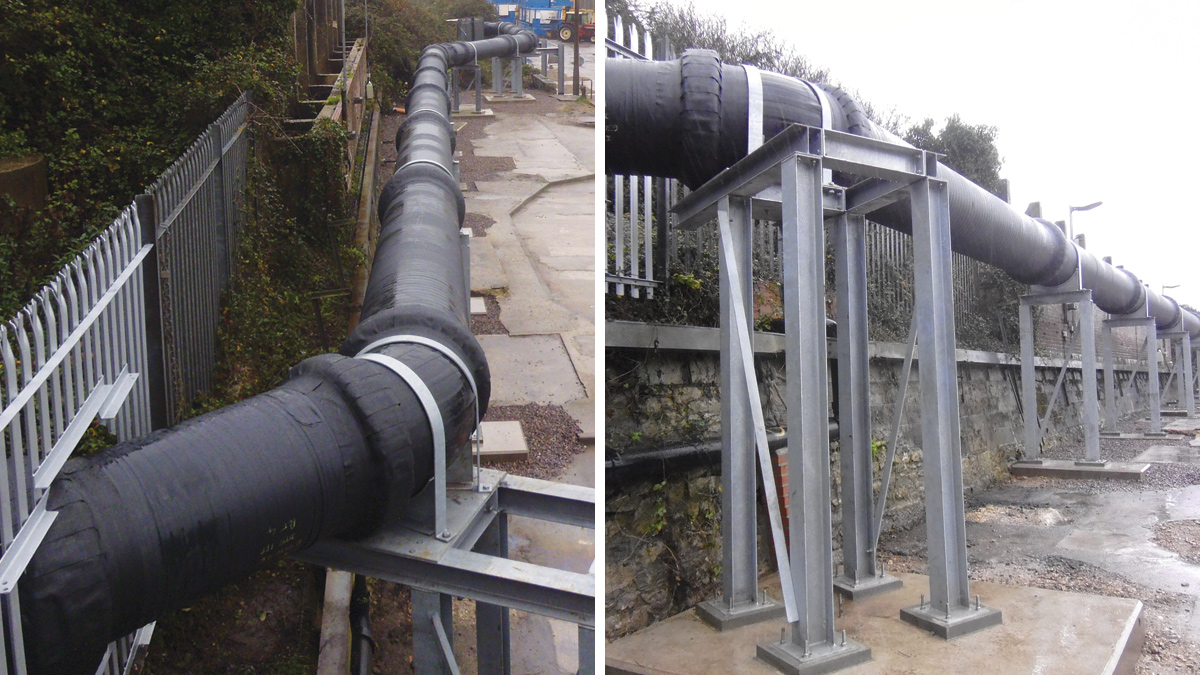
(left) Extent of bypass pipework showing downstream connection point and (right) Raised bypass sewer on galvanized supports - Courtesy of Wessex Water
During extreme weather conditions experienced across the UK in 2014, coastal areas saw conditions that would cause major flooding for residents and major concerns for all utility companies that had infrastructure within the affected areas. Portland being one of the most exposed coastal locations in the South suffered more than other areas. At the height of the storm Portland experienced 20ft high waves and prolonged heavy rain which caused landslides, flooding and moved several thousands of tons of stones on Chesil Beach. Wessex Water was contacted by Portland Port Authority and informed that an above ground 700mm diameter gravity sewer had been completely displaced by a large landslide within the Port. Wessex Engineering and Construction Services visited the site the following day to look at options for repairing the sewer.
Original sewer
The sewer was constructed back in the 1980s with the majority of the sewer being laid above ground due to concerns of security risks from the Ministry of Defence who owned the area in and around Portland Port. When constructed, the sewer was situated following the line of a historic disused railway and cut into the hillside which ran through the Port area. A small retaining wall protected the sewer in areas but its venerable position left it at risk should any movement occur about it within the hillside.
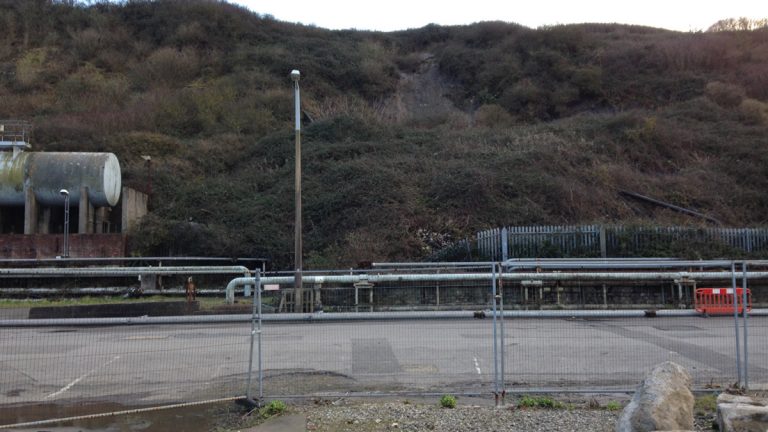
Original position of sewer was level with the back of the oil tank running parallel to the road – Courtesy of Wessex Water
Inspection after collapse
Once on site, the Repair and Maintenance (R&M) team discovered that the entire bank behind the above-ground sewer had collapsed, due to an extensive landslide moving a large section of the sewer and its concrete supports approximately 20m down the bank. Access to the sewer was very difficult and dangerous due to its position set back off the Port Haulage Road built along the line of the disused railway approximately 3m above ground level, which was now buried by the landslide.
The R&M team worked around the clock in shifts setting up over 1.8km of extensive overpumping utilising an existing structure within the Port and converting it into a temporary wet well. Two submersible pumps were then positioned within the wet well (operating duty/ standby) powered by generators (duty/standby).
Flows were pumped around the damaged section of the sewer using a temporary valve complex via two 8” above ground rising mains which had to be buried within the Port Haulage Road where they crossed from one side to the other.
During visits it was apparent that the landslide was still moving indicated by a gap within the damaged fence increasing over the duration of a week. As the landslide was still at risk of further movement a solution had to be developed which could piece back the damaged section of pipework but in a location which would not put the Engineering staff at risk during construction.
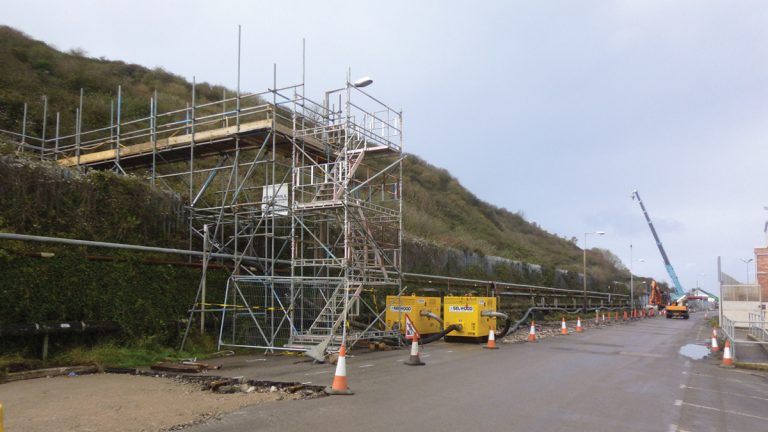
Scaffolding showing difficulties with accessing the existing sewer for over pumping – Courtesy of Wessex Water
Options
Several options were investigated including installing a pumping station but, due to the high flows, replicating the gravity sewer in another location away from the landslide was the favoured option.
Investigation work began with a full CCTV inspection of the existing sewer to check for any further damage and the positioning of existing manholes along the line of the sewer which, since construction in the 1980s, had been either buried by landslides along the length of the sewer or obscured by brambles and undergrowth within the inaccessible area where the sewer was located.
The investigation showed the rest of the sewer to be in good condition. Upstream of the collapse the sewer was accessed using scaffolding allowing an area to be cleared in order to find the sewer; here the existing sewer would be cut to allow the bypass section of sewer to be installed and connected onto the existing sewer upstream of the damaged section.
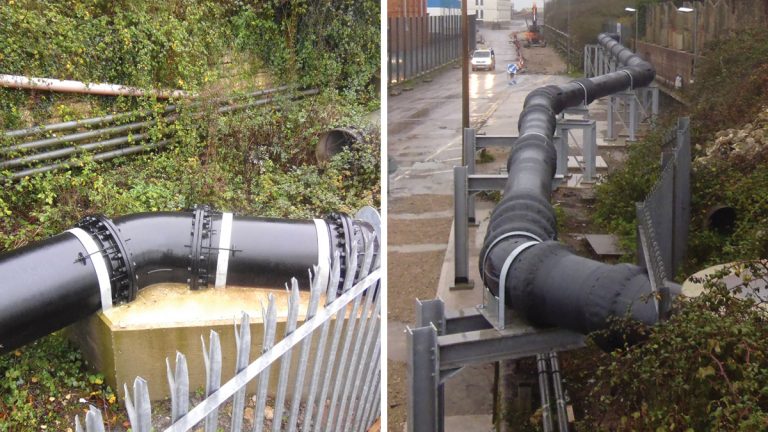
(left) Upstream connection point onto existing sewer. Original sewer can be seen in background and (right) Downstream section to maintain the road’s width and avoid the need for construction within the landslide area – Courtesy of Wessex Water
Solution
Due to the elevated position of the existing sewer, the new bypass section had to be elevated also as there was a retaining wall holding back the cliff/hill on one side and the busy Port Haulage Road on the other side.
The pipework was supported along its length by galvanized support legs with either two support legs or four depending on their positioning. Flows within the pipe can exceed 500l/s so the design had to allow for acting forces and ground conditions.
The line of the bypass sewer came out into the haulage road in one area in order to maintain a buffer zone between the land slip and the sewer and supports in case further land slips occurred. More recently, towards the end of 2015 Wessex Water realigned this section of sewer as the Port Authority had plans to widen the haulage road.
Wessex Water’s in-house design team designed below ground cantilever supports which allowed the bypass pipework to effectively hang over the landslide area allowing Wessex Construction Services to construct the support framework within a safe area away from the landslide. The cantilever supports also keep the pipework out of the busy Port Haulage Road as specified by the Port to allow them to continue with their development.
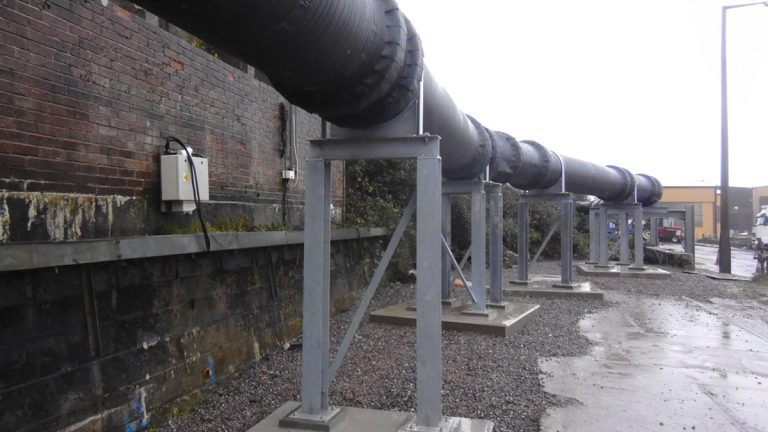
Raised supports – Courtesy of Wessex Water
Conclusion/summary
This scheme proved to be successful and was delivered within a very short time period after an unexpected failure of the sewer. Total costs for the scheme were in the region of £0.5m. A large proportion of these costs were attributed to the overpumping set up which required 1.8km of twin 8” overpumping mains, temporary duty/standby submersible pumps and duty standby diesel generators running 24 hours/day to cope with the significant flows which needed to be overpumped. Temporary switchgear, an ultrasonic sensor and telemetry was also installed to provide an automatic control over the system and notification when the temporary sump reached a high level.
Whilst the parallel above ground sewer provides a solution to the immediate issues there is still a risk of further landslides along the length of the sewer so long term solutions and options will be investigated aiming to remove all future risks of future collapses.


